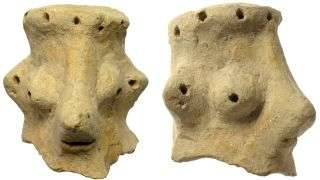
The head dates back almost 3,000 years and was found in a large building that may have been a palace.
A clay head that dates back almost 3,000 years may be a rare depiction of Yahweh, — God — whose image the Israelites were forbidden from creating according to the Ten Commandments, an archaeologist reports.
But two experts in the field have denounced the idea that this head figure represents God.
Yahweh is the God of Israel; however, according to the Hebrew Bible, the ancient Israelis were forbidden from creating depictions of Yahweh, as one of the 10 commandments stated that “you shall not make for yourself an image in the form of anything in heaven above or on the earth beneath or in the waters below” (Exodus 20:4).
Archaeologists discovered the 2-inch-tall (5 centimeters) head in the ruins of a large building that may have been a palace at the site of Khirbet Qeiyafa in Israel, wrote Yosef Garfinkel, head of the Institute of Archaeology at Hebrew University who co-directs excavations at Khirbet Qeiyafa, in a recent article published in the Biblical Archaeology Review.
“Because the base of the figure’s neck is well worked, the head likely was attached to another object, either a body or a pottery vessel,” Garfinkel wrote.
“With a flat top, the head has protruding eyes, ears and a nose,” and “because the ears are pierced, the figure may have worn earrings. Around the top of the head is a circle of holes,” which may be part of a headdress, Garfinkel wrote.
Why might this be Yahweh?
Garfinkel suspects that the clay head was once part of a figurine depicting Yahweh riding a horse.
His arguments to support this idea are complex.
For one, he argues that this is the only figurine found at Khirbet Qeiyafa that dates back around 3,000 years and it was found in a building that may be a palace, suggesting that the figurine was important to the people who lived there. The time period around 3,000 years is important since it’s a time period when many events in the Hebrew Bible may have taken place. For instance King Solomon, if he existed, may have lived around that time. Garfinkel believes that the people who lived at Khirbet Qeifaya at that time worshipped Yahweh.
In addition, biblical accounts tell of Yahweh riding in the skies: “For example, Psalm 68:4 reads, ‘Sing to God, sing praises to his name; lift up a song to him who rides upon the clouds,'” wrote Garfinkel. He noted that there is also an important example from the Book of Habakkuk, that describes God riding a horse: “”[W]as your wrath against the rivers, O Lord? Or your anger against the rivers, or your rage against the sea, when you drove your horses, your chariots to victory?” (Habakkuk 3:8)
Though no other such figurines have been found at Khirbet Qeiyafa, similar ones — with a figure that’s possibly Yahweh riding a horse — dating back nearly 3,000 years have been found in a temple and burial tombs in Israel. For instance, at the site of Tell Moza, in Israel, recent excavations uncovered two head figurines and two horse figurines within a temple, Garfinkel said. Those figurines also date back almost 3,000 years, and Garfinkel thinks those figurines originally showed two depictions of Yahweh riding a horse. The two heads are designed in a similar way to the head at Khirbet Qeiyafa, Garfinkel wrote.
“Even if we were to identify the figures as depictions of gods, they could not have represented Yahweh, as he did not appear in the region before the 9th century B.C.”
Oded Lipschits & Shua Kisilevitz
Additionally, the collection of the late Moshe Dayan, an Israeli military leader, includes a vessel showing a rider on a horse, which, based on Dayan’s notes, he may have looted from a burial cave in the Hebron Hills and may also date back almost 3,000 years, Garfinkel wrote in the article. Moshe Dayan was often accused of being actively involved in the looting of archaeological sites.
Garfinkel argues that these figurines were found in revered places — like a palace, temple or burial cave — because they are representations of Yahweh. For the Israelites who lived at the time, seeing a visual depiction of God was important, he said.
“As the believer sees the face of the idol, in that very moment the idol also looks at the believer. This is a metaphysical moment, a contact between earth and heaven, the core of the religious experience,” Garfinkel wrote. Across the ancient Near East, it “was a common practice” for people to be able to see an image of a deity within a temple or other important place, Garfinkel wrote.
Garfinkel believes that the ban on Israelis depicting Yahweh didn’t occur until later times, perhaps around the eighth century B.C., though the exact timing is not known
Live Science contacted several scholars not affiliated with Garfinkel’s work to get their thoughts on the Khirbet Qeiyafa head and Garfinkel’s interpretation of it.
Most were unable to reply at press time. However, Oded Lipschits, an archaeologist at Tel Aviv University who co-directs excavations at Tell Moza, and Shua Kisilevitz, an archaeologist with the Israel Antiquities Authority and Tel Aviv University who excavates at Tell Moza, denounced the idea in a jointly written response.
“Although we cannot rule out the possibility that the human heads from Moẓa and Qeiyafa depicted gods, they have no markings, symbols or attributes — such as horns, crescents, bulls — found on figures and visual representations throughout the ancient Near East, that would identify them as divine figures. Furthermore, when gods were depicted on animals, they did not sit on them — they do not need the transport — they stood on them,” Lipschits and Kisilevitz told Live Science in their response.
They also said that archaeological and historical research indicates that around 3,000 years ago Yahweh wasn’t even worshipped in the region yet, much less was he the sole god of Israel.
Related
—Biblical battles: 12 ancient wars lifted from the Bible
—The 25 most mysterious archaeological finds on Earth
—30 of the world’s most valuable treasures that are still missing
“Even if we were to identify the figures as depictions of gods, they could not have represented Yahweh, as he did not appear in the region before the 9th century B.C. Throughout the period, at least until the very end of the 7th century [B.C.], a pantheon of Canaanite gods was worshipped throughout the Land of Israel. This pantheon was initially headed by the god El, and from the 9th century [B.C] Yahweh became the chief god,” they added.
Earlier biblical names — such as Samuel, Ezekiel, Bethel, Jezreel, Penuel, Israel — referenced the god “El,” and it wasn’t until the mid ninth century B.C. that names that reference Yahweh such as Jehoshaphat, Ahaziyah and Hezekiah, began to appear in the region.
Overall “Garfinkel’s article is riddled with factual inaccuracies and a flawed methodological approach, which ignores all the current and most relevant publications, both in the study of cult in the ancient Near East and of the Moẓa temple and its cultic artifacts by the excavators,” wrote Lipschits and Kisilevitz adding that a more detailed response will be published in a future issue of Biblical Archaeology Review and on the publication’s website.
Sourse: www.livescience.com





